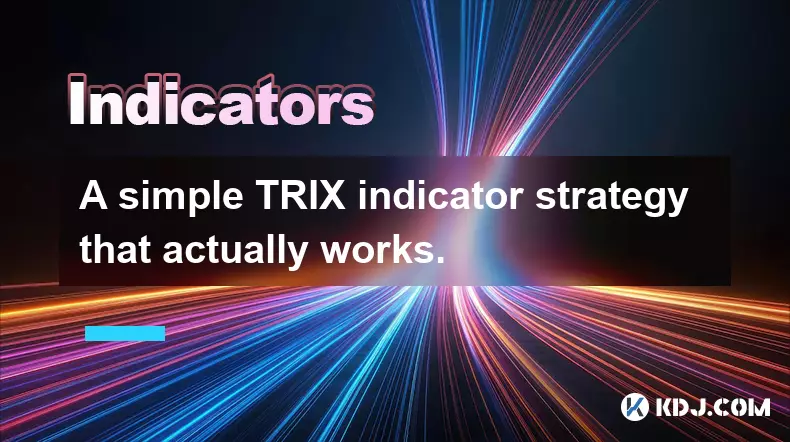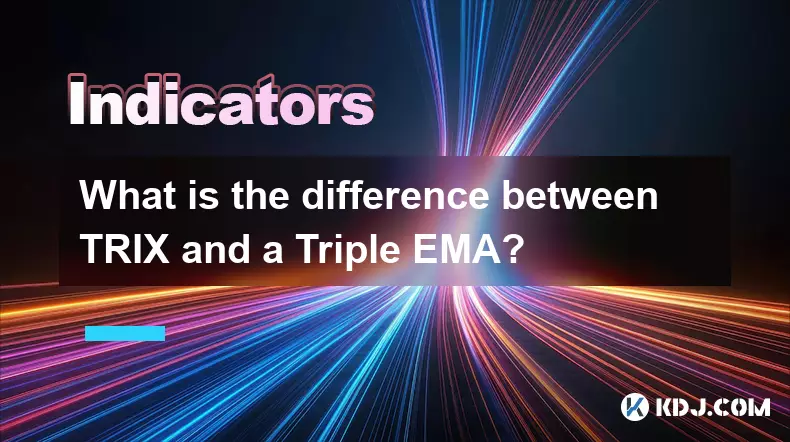-
 bitcoin
bitcoin $101752.865364 USD
-1.09% -
 ethereum
ethereum $3382.985899 USD
-1.38% -
 tether
tether $0.999658 USD
0.04% -
 xrp
xrp $2.272505 USD
-1.51% -
 bnb
bnb $989.089004 USD
0.14% -
 solana
solana $156.962612 USD
-3.08% -
 usd-coin
usd-coin $0.999776 USD
0.01% -
 tron
tron $0.290786 USD
-0.69% -
 dogecoin
dogecoin $0.174594 USD
-2.86% -
 cardano
cardano $0.560085 USD
-3.55% -
 hyperliquid
hyperliquid $40.023704 USD
-5.75% -
 chainlink
chainlink $15.324649 USD
-2.78% -
 bitcoin-cash
bitcoin-cash $493.576540 USD
-3.52% -
 zcash
zcash $571.320038 USD
-12.05% -
 stellar
stellar $0.280066 USD
-4.26%
How do you read the K, D, and J lines on the KDJ indicator?
The KDJ indicator uses K, D, and J lines to spot overbought/oversold levels and crossovers, helping traders time entries and exits in crypto markets.
Aug 02, 2025 at 12:22 pm

Understanding the Components of the KDJ Indicator
The KDJ indicator is a momentum oscillator widely used in cryptocurrency trading to identify overbought and oversold conditions. It consists of three lines: the K line, the D line, and the J line. Each of these lines plays a distinct role in interpreting market momentum and potential reversal points. The K line is known as the fast stochastic, the D line is the slow stochastic, and the J line represents the divergence between the K and D lines. These values are derived from price data, typically using the highest high, lowest low, and closing price over a defined period, commonly 9 periods.
The calculation begins with the raw stochastic value (RSV), which measures where the current closing price stands relative to the recent price range. The formula for RSV is:RSV = [(Current Close – Lowest Low) / (Highest High – Lowest Low)] × 100The Lowest Low and Highest High are determined over the specified lookback period. Once the RSV is calculated, the K line is derived using a smoothing formula:K = (2/3) × Previous K + (1/3) × RSVInitially, K is often set to 50 if no prior value exists. The D line is then calculated as a moving average of the K line:D = (2/3) × Previous D + (1/3) × Current KThe J line is computed as:J = 3 × K – 2 × DThis amplifies the volatility of the K and D lines, making the J line more sensitive to price changes.
Interpreting the K Line in Crypto Trading
The K line reflects the short-term momentum of an asset’s price. When the K line rises above 80, it suggests the cryptocurrency may be overbought, indicating a potential pullback or correction. Conversely, when the K line falls below 20, it signals an oversold condition, which may precede a price rebound. Traders monitor the slope and direction of the K line to assess momentum strength. A sharply rising K line implies strong buying pressure, while a steep decline indicates aggressive selling.
It is crucial to consider the K line in context with broader market trends. In a strong uptrend, the K line may remain above 50 for extended periods, and brief dips into overbought territory do not necessarily signal reversals. Similarly, in a downtrend, frequent oversold readings may not indicate immediate buying opportunities. The K line should not be used in isolation; combining it with volume data or trend indicators like moving averages enhances its reliability.
Using the D Line for Signal Confirmation
The D line acts as a signal line for the K line, providing filtered insights into market momentum. Because it is a moving average of the K line, the D line moves more slowly and helps reduce false signals. Crossovers between the K and D lines are commonly used to generate trading signals. When the K line crosses above the D line, especially from below 20, it may indicate a bullish signal. Conversely, when the K line crosses below the D line from above 80, it may suggest a bearish reversal.
To apply this in a trading platform like TradingView or Binance Futures, follow these steps:
- Open the chart of the desired cryptocurrency pair (e.g., BTC/USDT).
- Click on the 'Indicators' button and search for 'KDJ'.
- Select the KDJ indicator and ensure the default settings (usually 9, 3, 3) are applied.
- Observe the interaction between the K and D lines.
- Wait for a confirmed crossover near overbought or oversold thresholds.
- Validate the signal with candlestick patterns or support/resistance levels.
Role of the J Line in Detecting Extremes
The J line is the most volatile of the three and often moves beyond the 0–100 range. Values above 100 suggest extreme overbought conditions, while values below 0 indicate severe oversold levels. Because the J line exaggerates movements, it can provide early warnings of potential reversals. For example, if the J line spikes to 120 while the price continues to rise, it may indicate weakening momentum despite the uptrend.
Traders use the J line to identify divergence. Bullish divergence occurs when the price makes a lower low, but the J line forms a higher low, suggesting underlying strength. Bearish divergence happens when the price reaches a higher high, but the J line peaks at a lower level, signaling weakening momentum. This type of analysis is particularly useful in ranging markets or during consolidation phases in cryptocurrencies like ETH or SOL.
Practical Application on a Crypto Chart
To set up and read the KDJ indicator on a crypto exchange:
- Navigate to the trading interface on platforms such as Bybit or KuCoin.
- Load the price chart for your chosen asset.
- Access the indicators menu and type 'KDJ' in the search bar.
- Apply the indicator and adjust parameters if needed (e.g., period length).
- Enable grid lines at 20 and 80 for visual reference.
- Monitor for K/D crossovers near these thresholds.
- Use the J line to confirm extreme readings or divergence.
- Combine with RSI or MACD for confluence.
For instance, if ADA/USDT shows the K line crossing above the D line at 18, with the J line rising from -10, and the price bounces off a key support level, this could signal a valid long entry. Conversely, if BNB reaches a new high but the J line drops from 110 to 90 while the price climbs, it may warn of an impending correction.
Common Misinterpretations and How to Avoid Them
A frequent error is acting on KDJ signals without considering the broader trend. In a strong bull market, waiting for the K line to drop below 20 may cause traders to miss upward moves. Similarly, selling solely because the J line exceeds 100 in a breakout phase can lead to early exits. Another mistake is ignoring timeframe alignment—a signal on the 15-minute chart may contradict the daily trend.To avoid false signals:
- Use the KDJ on multiple timeframes (e.g., 1H, 4H, daily).
- Confirm signals with volume spikes or order book depth.
- Avoid trading against the dominant trend unless divergence is strong.
- Apply stop-loss orders to manage risk when acting on KDJ crossovers.
FAQsWhat does it mean when the J line is negative?A negative J line indicates that the K line is significantly below the D line, often occurring during sharp sell-offs. It suggests extreme oversold conditions and potential for a bounce, especially if accompanied by rising volume.
Can the KDJ indicator be adjusted for different crypto assets?Yes. While the default is 9,3,3, volatile assets like DOGE may benefit from a longer period (e.g., 14,3,3) to reduce noise. Less liquid tokens might require smoothing to avoid erratic signals.
How do I know if a K/D crossover is reliable?A crossover is more reliable when it occurs near the 20 or 80 levels, aligns with support/resistance zones, and is confirmed by volume or candlestick patterns like bullish engulfing or hammer formations.
Is the KDJ suitable for scalping in crypto?Yes, on shorter timeframes like 1-minute or 5-minute charts, the KDJ can help identify quick entries and exits. However, due to its sensitivity, it should be combined with a fast EMA or order flow data to improve accuracy.
Disclaimer:info@kdj.com
The information provided is not trading advice. kdj.com does not assume any responsibility for any investments made based on the information provided in this article. Cryptocurrencies are highly volatile and it is highly recommended that you invest with caution after thorough research!
If you believe that the content used on this website infringes your copyright, please contact us immediately (info@kdj.com) and we will delete it promptly.
- Ripple (XRP) in 2026: Hold or Fold? A Look at XRP's Future and Emerging DeFi Alternatives
- 2025-11-08 18:35:01
- Zcash ZEC Coin Price Explosion: From Privacy Niche to Center Stage
- 2025-11-08 18:55:01
- Berachain Price Prediction: Navigating the Honeycomb Hype in Crypto
- 2025-11-08 18:55:01
- Arthur Hayes, Gold, and Bitcoin: A Modern Monetary Trinity?
- 2025-11-08 19:15:01
- Shiba Inu's Next Move: Navigating a Shifting Market
- 2025-11-08 19:20:01
- Pakistan's Crypto Crossroads: Balancing Opportunity with Asset-Backed Realities
- 2025-11-08 19:20:01
Related knowledge

How do professional traders use the TRIX indicator?
Nov 06,2025 at 04:40pm
Understanding the TRIX Indicator in Crypto TradingThe TRIX (Triple Exponential Average) indicator is a momentum oscillator used by professional trader...

Can I use the TRIX indicator on my mobile trading app?
Nov 07,2025 at 07:40pm
The TRIX indicator, a momentum oscillator designed to filter out short-term fluctuations and highlight long-term trends, has become increasingly popul...

How to code a simple TRIX indicator script in Pine Script?
Nov 07,2025 at 06:20am
How to Code a Simple TRIX Indicator in Pine Script The TRIX (Triple Exponential Moving Average) indicator is widely used in cryptocurrency trading to ...

A simple TRIX indicator strategy that actually works.
Nov 08,2025 at 05:39pm
Understanding the TRIX Indicator in Crypto Trading1. The TRIX (Triple Exponential Average) indicator is a momentum oscillator designed to filter out s...

What is the difference between TRIX and a Triple EMA?
Nov 10,2025 at 04:00am
Understanding Decentralized Exchanges in the Crypto Ecosystem1. Decentralized exchanges (DEXs) have emerged as a cornerstone of blockchain innovation,...

How to trade TRIX indicator signals on the 1-hour chart?
Nov 07,2025 at 05:39am
Bitcoin's Role in Decentralized Finance1. Bitcoin remains the cornerstone of decentralized finance, serving as a benchmark for value and security acro...

How do professional traders use the TRIX indicator?
Nov 06,2025 at 04:40pm
Understanding the TRIX Indicator in Crypto TradingThe TRIX (Triple Exponential Average) indicator is a momentum oscillator used by professional trader...

Can I use the TRIX indicator on my mobile trading app?
Nov 07,2025 at 07:40pm
The TRIX indicator, a momentum oscillator designed to filter out short-term fluctuations and highlight long-term trends, has become increasingly popul...

How to code a simple TRIX indicator script in Pine Script?
Nov 07,2025 at 06:20am
How to Code a Simple TRIX Indicator in Pine Script The TRIX (Triple Exponential Moving Average) indicator is widely used in cryptocurrency trading to ...

A simple TRIX indicator strategy that actually works.
Nov 08,2025 at 05:39pm
Understanding the TRIX Indicator in Crypto Trading1. The TRIX (Triple Exponential Average) indicator is a momentum oscillator designed to filter out s...

What is the difference between TRIX and a Triple EMA?
Nov 10,2025 at 04:00am
Understanding Decentralized Exchanges in the Crypto Ecosystem1. Decentralized exchanges (DEXs) have emerged as a cornerstone of blockchain innovation,...

How to trade TRIX indicator signals on the 1-hour chart?
Nov 07,2025 at 05:39am
Bitcoin's Role in Decentralized Finance1. Bitcoin remains the cornerstone of decentralized finance, serving as a benchmark for value and security acro...
See all articles





















![The Graph Price Prediction [GRT Crypto Price News Today] The Graph Price Prediction [GRT Crypto Price News Today]](/uploads/2025/11/07/cryptocurrencies-news/videos/690d4df44fe69_image_500_375.webp)




















































